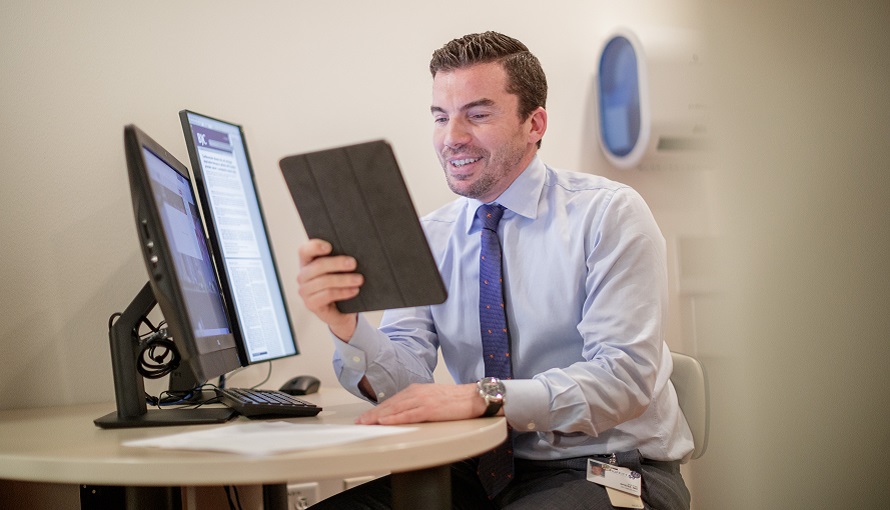
Virtual Oncology Visits Are Up 5,000% at Moffitt— Are They Here to Stay After COVID-19?
The virulent spread of COVID-19 throughout the country, along with resulting patient surges, has accelerated the need for comprehensive telehealth services to protect hospital staff and vulnerable patient populations. With compromised immune systems, oncology patients remain one of the most vulnerable groups, with increased susceptibility to virus contagion. In response to the pandemic, Congress and the Department of Health and Human Services have relaxed HIPPA restrictions for telehealth along with expanded insurance coverage to include telehealth services.1,2 As a result, virtual visits at Moffitt Cancer Center are up by 5,000% since the pandemic began and Moffitt’s telehealth services expanded from existing patients to include new patient visits and those in need of second opinions.3
Moffitt’s Virtual Visits program was launched approximately two years ago with 30 providers participating. Prior to the COVID-19 pandemic, virtual visits were being offered by medical oncologists, surgeons, advanced practice professionals, nurses and non-clinical providers such as genetic counselors and dietitians. As adoption ramped up, the number of visits from last fiscal year to the current fiscal year was already doubling and looking to continue to grow. Likewise, the number of providers using telemedicine also doubled year-over-year. The COVID-19 national health crisis, however, has accelerated the utilization of virtual visits at Moffitt exponentially.
“Right now in the Tampa area, like much of the country, we are in a challenging situation where COVID-19 is affecting a large number of people,” said Philippe Spiess, MD, surgical genitourinary oncologist and Medical Director of Virtual Health at Moffitt. “COVID-19 poses a significant risk to our patient population at the cancer center particularly. By being able to see patients virtually—using both audio and visual technology—we are able to connect with patients real-time and address many of their significant medical concerns while minimizing the exposure risk.”
Accelerating Adoption
The pandemic spurred Moffitt to ramp up its efforts expeditiously to protect the health of its patients and community. The virtual health team quickly identified the best platform, trained staff and assembled educational information for patients. The newly expanded platform is straightforward, secure and HIPAA compliant for both patients and team members. “We want to make sure to use a platform that protects our patient’s unique information and ensure no identified data is shared outside of that visit. Security was a key factor in choosing the platform,” said Spiess.
In early March, Moffitt worked swiftly to convert existing patient appointments to telehealth via Zoom while simultaneously onboarding providers to accommodate. Clinical teams work diligently to review all already-scheduled patient appointments in advance to determine whether a “virtual” or “in-person” visit is most appropriate for the patient. “In this time, it is critical for providers to identify which patients are suitable for telemedicine visits,” Spiess relayed. “Providers know their patients best and this requires provider engagement and often discussion with the care team. This will allow those patients to be proactively approached about converting from in-person to telemedicine visits [and] ultimately ensure the best experience for both the provider and the patient.”
As of April, there were over 200 unique Moffitt providers offering virtual care, completing more than 300 virtual visits with new and existing patients per day. Over 4,000 virtual total visits are anticipated monthly in the future. With relaxed state and federal telemedicine regulations, Moffitt can virtually see its patients from select states across the country, including in Arizona, California, Colorado, Connecticut, Delaware, Florida, Hawaii, Indiana, Iowa, Mississippi, New Hampshire, New Mexico, New York, North Carolina, North Dakota, Oregon, Pennsylvania, Tennessee, Washington D.C., and West Virginia.
When providers conduct the appointment virtually, patients still receive the same level of care as in a face-to-face visit, and a virtual visit reduces the risk of COVID-19 infection by staying home. However, telehealth is not for every oncology patient—specifically those in the middle of life-saving treatments. “Clearly telemedicine is not something to be adopted for every patient we see at the cancer center,” said Spiess. “Some of our patients require a fairly extensive physical examination as part of their initial assessment or their continued evaluation—or are receiving active treatment in the form of infusion, radiation, surgical or other specialty care. We will need to continue to see those patients in-person provided we feel it is safe to do so.”
Moffitt now has a more robust telehealth program and can use the technology in the present and future to deliver care to patients unable to travel. "After all this is all said and done—whether it be three months, six months, one year—telemedicine is here to stay," Spiess said. "I think a lot of the work and a lot of the effort that is being put into this will be very meaningful for our patients and providers in the future."
To learn more about Moffitt's safety response to COVID-19, click here.
To refer a patient for an in-person or virtual visit, complete our online form, call 1-888-663-3488, or contact a physician liaison for assistance or support. As part of our efforts to shorten referral times as much as possible, online referrals are typically responded to within 24 – 48 hours.
References:
- S. Centers for Medicare & Medicaid Services. Telehealth. https://www.medicare.gov/coverage/telehealth. Accessed March 26, 2020.
- S. Department of Health & Human Services. Notification of Enforcement Discretion for Telehealth Remote Communications During the COVID-19 Nationwide Public Health Emergency. https://www.hhs.gov/hipaa/for-professionals/special-topics/emergency-preparedness/notification-enforcement-discretion-telehealth/index.html. Accessed March 26, 2020.
- Drees J. Moffitt Cancer Center's virtual visits up 5,000% in response to COVID-19. Beckers. https://www.beckershospitalreview.com/telehealth/moffitt-cancer-center-s-virtual-visits-up-5-000-in-response-to-covid-19.html. Accessed April 17, 2020.
